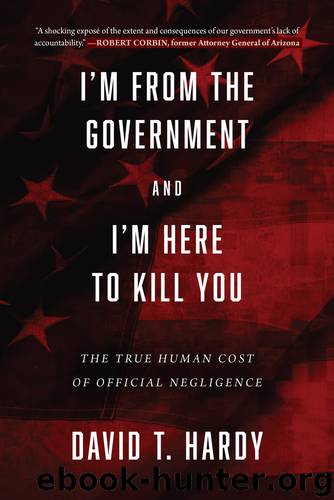I'm from the Government and I'm Here to Kill You by David T. Hardy

Author:David T. Hardy
Language: eng
Format: epub
Publisher: Skyhorse Publishing
Published: 2017-09-19T04:00:00+00:00
AT LAST! THE GOVERNMENT (ALMOST) TARGETS BIN LADEN
The dangers posed by al-Qaeda and bin Laden were no secret. In 1995, the CIA had released a National Intelligence Estimate titled “The Foreign Terrorist Threat in the United States”; in 1997, it issued another Estimate that warned: “Civil aviation remains a particularly attractive target for terrorist attacks.” In 1998, it gave Bill Clinton a Presidential Daily Briefing report titled “Bin Ladin Preparing to Hijack U.S. Aircraft and Other Attacks.”22
But an appropriately lethal response to bin Laden’s attacks was hindered by a peculiar legal barrier. Back in 1975, CIA and FBI activities had been investigated by the Church Committee, a Senate committee chaired by Senator Frank Church. Its work was highly critical of CIA activities, including involvement in some homicides overseas.
In 1976, President Gerald Ford responded with Executive Order 11905, which forbade federal employees to “engage in, or conspire to engage in, political assassination.” Two years later a similar command, Executive Order 12036, was issued by President Jimmy Carter: the principal difference was to remove the word “political” before “assassination.”
Then in 1981, President Reagan signed Executive Order 12333, which had still broader restrictions. Part 2.11 provided, “No person employed by or acting on behalf of the United States Government shall engage in, or conspire to engage in, assassination.” The ban covered not only federal employees but any person “acting on behalf of” the government. Part 2.12 reinforced this point: no federal agency could “request any person to undertake activities forbidden by this Order.”
But none of these Executive Orders defined the word “assassination.” No one seems to have thought that the sniper who shot and tried to kill Randy Weaver and Kevin Harris was attempting an “assassination,” or that the Hostage Rescue Team leader who ordered his snipers to shoot any armed male on sight was ordering them to undertake an “assassination.” Nor would anyone use that word to describe one soldier’s shooting of an enemy soldier. Perhaps “assassination” applies only to lethal termination of foreign government officials? Or perhaps only to those above a certain pay grade? Whatever the definition, in practice, the government’s understanding seems to have been that putting a bullet into Osama bin Laden would be a forbidden assassination, while putting one into Vicki Weaver was merely a justifiable homicide.
In 1998, President Clinton signed a document essentially authorizing killing bin Laden as long as the death was incidental to other pursuits—i.e., incidental to capturing him alive.23 If in the course of making an “arrest” bin Laden resisted and had to be shot, that was permissible, but taking him out with a sniper shot or a Hellfire missile was not. In preparation for this “arrest,” a federal grand jury was readied to issue the appropriate indictment.
Bin Laden was fighting a war, and our government was answering with a legal proceeding. The proceeding would be governed by the usual civilian rules: no killing the defendant unless it was purely incidental to his apprehension. Do not kill an associate who might be standing near him.
Download
This site does not store any files on its server. We only index and link to content provided by other sites. Please contact the content providers to delete copyright contents if any and email us, we'll remove relevant links or contents immediately.
| Anthropology | Archaeology |
| Philosophy | Politics & Government |
| Social Sciences | Sociology |
| Women's Studies |
The Secret History by Donna Tartt(16635)
The Social Justice Warrior Handbook by Lisa De Pasquale(11490)
Thirteen Reasons Why by Jay Asher(7793)
This Is How You Lose Her by Junot Diaz(5779)
Weapons of Math Destruction by Cathy O'Neil(5039)
Zero to One by Peter Thiel(4828)
The Myth of the Strong Leader by Archie Brown(4792)
Promise Me, Dad by Joe Biden(4451)
Beartown by Fredrik Backman(4423)
Stone's Rules by Roger Stone(4418)
How Democracies Die by Steven Levitsky & Daniel Ziblatt(4401)
The Fire Next Time by James Baldwin(4345)
100 Deadly Skills by Clint Emerson(4080)
A Higher Loyalty: Truth, Lies, and Leadership by James Comey(4034)
Rise and Kill First by Ronen Bergman(4013)
The David Icke Guide to the Global Conspiracy (and how to end it) by David Icke(3884)
The Farm by Tom Rob Smith(3873)
Secrecy World by Jake Bernstein(3784)
The Doomsday Machine by Daniel Ellsberg(3734)
